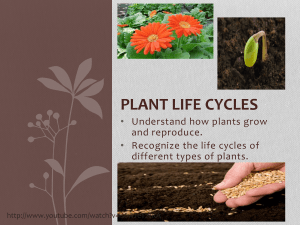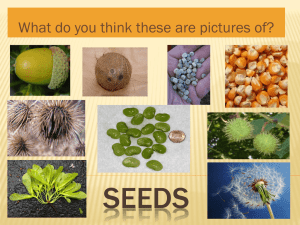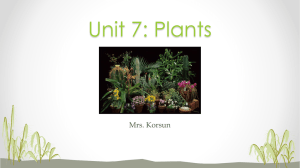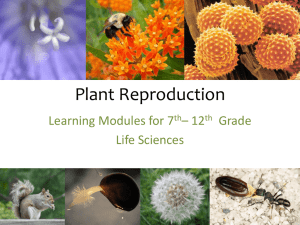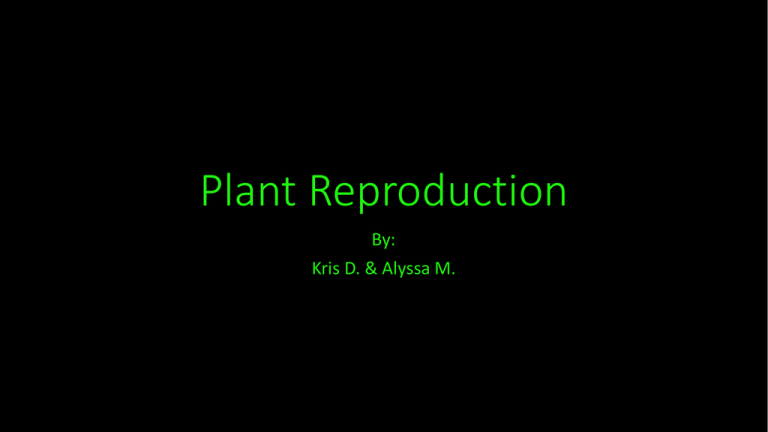
Plant Reproduction
By:
Kris D. & Alyssa M.
Vocabulary
• Ovule- Contains the female sex cells
• Pollen Grain- Contains the male sex cells
• Pollen Tube- Acts as a conduit to bring male sex cells to the ovarys
• Anther- were the pollen develops
Vocabulary Cont.
• Carpel- leaves that cover the ovules
• Filament- Supports the anther
• Ovary- female organ of a flower
• Petal- Modified leaves that surround the reproductive parts of the
flower
Vocabulary Cont.
• Pistil- Female reproductive part of the flower
• Polar Nuclei- Two female haploid nuclei in the embryo sac
• Receptacle- Is the part of the stem where the bud forms
• Sepal- The outer leaves of the flower that protects the flower from
clod or injuries
Vocabulary Cont.
• Stamen- Pollen producing part of a flower
• Stigma- The part if the flower the reviving pollen during pollination
• Style- Supports the ovule
• Epicotyl- The part of seed that will become the plant
Vocabulary Cont.
• Hilum- Scar where the seed was attached to the seed vessel
• Hypocotyl- Stem of the germinating seed
• Plumule- Embryonic leaves
• Radicle- Embryonic root of the plant
• Seed Coat- hard outer layer that protects the seed during germination
Parts of a flower
• Pistil
• Stigma
• Style
• Ovule
• Function
• Where the female sex cells are made, fertilized, and mature
Parts Cont.
• Stamen
• Where pollen grains are made
• Anther
• Where male sex cells are made
• Filament
• Long thin structure that supports an Anther
Parts Cont.
• Sepal
• Leaf like structure that encloses the bud of a flower
• Carpels
• Female reproductive organ of a flower consisting of the stigma, style, and
ovary
Rings of petals
1.
2.
3.
4.
Sepals
Petals
Stamens
Ovary
Being a successful Reproducer
• Adaptations for reproduction
• Bright colors
• Scent
• Shape and size
Why are these adaptations useful?
• Used to attract animals for pollination
•
•
•
•
Bees
Birds
Flies
Small rodents
Double Fertilization
• Double Fertilization- process involves the joining of a female sex cell
with two male sex cells
• Endosperm- the part of the seed that acts as a food store for the
developing plant embryo
Step 1
• Pollen grain adheres to the stigma
• Pollen grain takes in moisture and begins to germinate forming a
pollen tube
• Pollen tube extends down toward the ovary through the style
• Tip of the pollen tube enter the ovary and penetrates through the
micropyle opening in the ovule
• Release the two sperm in the ovule
Step 2
• One sperm fertilizes the egg
• One sperm combines with the two polar nuclei
• Haploid egg and sperm from the diploid zygote
• Two haploid polar nuclei and the egg form a triploid nucleus
• Some may form polyploidy
• Then develop into the endosperm
Fruit
• Fruit- sweet and fleshy product of a tree or other plant that contains
seed and can be eaten as food
• Made in ovaries of plant
• Made of maternal tissue
Purpose
• Protect seed
• Delays sprouting until right conditions are available
• Dispersal
Types of Fruit
• Simple
• One ovary in one flower formed one pistol
• Examples
•
•
•
•
•
•
Peas
Corn
Wheat
Cherry
Tomato
Apple
Types of Fruit
• Aggregate
• Formed from several pistils of a signal flower
• Examples
• Raspberries
• Strawberries
Types of Fruit
• Multiple
• Formed from several flower all growing together
• Examples
• Pineapple
• Fig
Parts of the fruit
Dispersal
• Wind picks up seed and moves them the different areas
• Example of plant that use this are
• Orchids
• Dandelions
Dispersal
• Animals eat fruit
• Seeds pass unharmed through animals digestive system
• Examples of plants that use this are
• Date
• Sunflowers
• Raspberry
Dispersal
• Water
• The seeds float and are then carried by the water with the current
until the wash a shore and start to grow
• Examples of plants that use this are
• Yellow Flag
• Foxglove
• Willow
Dispersal
• Gravity
• Some have a hard outer shell and when they hit the ground they roll
away form the parent
• If they have soft skins when they fall the will crack open and the
individual seeds my be scattered
• After falling they use animals to finish the job
• Examples of plant that use this are
• Passion fruit
• Canna
• Salvia
Monocot Seeds
• Only one seed leaf inside the seed coat because they do not have the
endosperm to feed the new plant
Germination- monocots
• Single cotyledon stays below ground and within the seed where it
digests the endosperm and transfers the stored energy to the
developing plant
• The radical portion of the plant is aborted and only fibrous,
adventitious roots are produced
Dicot seeds
• Two seed leaves inside the seed coat because they contain the
endosperm to feed the plant
Germination-Dicots
• The cotuledons are well developed and absorb and store nutritive
tissue from the endosperm of the seed then they are often pushed up
out of the soil and serve as the plants first leaves
Videos
• https://www.youtube.com/watch?v=bUjVHUf4d1I
• https://www.youtube.com/watch?v=rhp5k5ptSx0
• https://www.youtube.com/watch?v=L4Ig8J2b2Ag
• https://www.youtube.com/watch?v=V5yya4elRLw
• https://www.youtube.com/watch?v=l-uK5ulLBr8
Plant Review
• Plant Reproduction
• http://quizlet.com/33480219/plant-reproduction-flash-cards/
• http://www.thecoloringpics.net/314571-plant-structure-reproductiondevelopment-anatomy-of.html
• http://quizlet.com/33480219/plant-reproduction-flash-cards/
• http://www.thecoloringpics.net/314571-plant-structure-reproductiondevelopment-anatomy-of.html
Plant Review
• Parts of a Flower
• http://www.slideserve.com/analise/review-parts-of-a-flower
Work Cited
• http://quizlet.com/12838194/flower-structure-and-function-flashcards/
• http://theseedsite.co.uk/sdwater.html
• http://lumberjack.hubpages.com/hub/how-do-seeds-germinatemonocots-vs-dicots
Work Citied
•
•
•
•
•
http://urbanext.illinois.edu/gpe/case1/c1facts2d.html
http://www.countrysideinfo.co.uk/images/flwdiag.JPG
http://www.geekygirlengineer.com/corpse-flower/
http://www.viralnova.com/nsfw-orchids-ahead/
http://www.dailymail.co.uk/news/article-2384654/A-bugs-life-Beepictured-covered-nectar-tucks-flowers-pollen.html
• kvhs.nbed.nb.ca/gallant/biology/angiosperm_reproduction.jpg
• https://tse1.mm.bing.net/th?id=HN.608024132368401235&w=258&h=170
&c=7&rs=1&pid=1.7
• https://tse3.mm.bing.net/th?id=HN.608047758981923089&w=224&h=168
&c=7&rs=1&pid=1.7
Work Cited
• http://depann2000.com/gallery/temp/pollen-grains-diagram-7119.jpg
• https://tse4.mm.bing.net/th?id=HN.608003976086883310&pid=1.7
• https://tse1.mm.bing.net/th?&id=HN.607991434788209808&w=300&h=3
00&c=0&pid=1.9&rs=0&p=0
• http://cnx.org/content/m44723/latest/Figure_32_02_09.png
• https://tse1.mm.bing.net/th?&id=HN.607991434788209808&w=300&h=3
00&c=0&pid=1.9&rs=0&p=0
• http://simplepleasuresforspecialseniors.com/wpcontent/uploads/2008/08/buy_apple.jpg
• https://tse1.mm.bing.net/th?id=HN.608024978482528522&w=250&h=167
&c=7&rs=1&pid=1.7
Work cities
• https://tse1.mm.bing.net/th?id=HN.608032318578558049&w=261&h=187&c=7&rs=1&
pid=1.7
• https://tse2.mm.bing.net/th?id=HN.607988509912338064&w=246&h=164&c=7&rs=1&
pid=1.7
• https://tse3.mm.bing.net/th?id=HN.607990700346445136&w=185&h=184&c=7&rs=1&
pid=1.7
• https://tse4.mm.bing.net/th?id=HN.608036819709264473&w=271&h=181&c=7&rs=1&
pid=1.7
• http://www.doctortee.com/dsu/tiftickjian/cse-img/botany/plant-anat/fruit-seed/cornseed.png
• https://tse4.mm.bing.net/th?id=HN.608046981601560844&w=256&h=168&c=7&rs=1&
pid=1.7
• http://faculty.coventryschools.net/contijanet/images/seed.jpg
• http://bio1152.nicerweb.com/Locked/media/ch38/38_10SeedGermination-dicot.jpg


